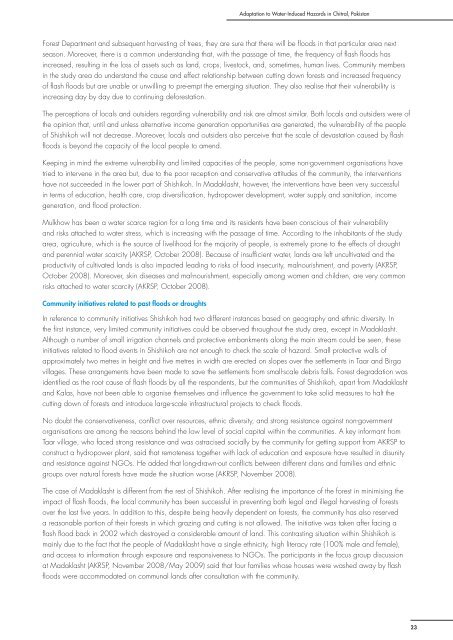Full Document - Himalayan Document Centre - icimod
Full Document - Himalayan Document Centre - icimod
Full Document - Himalayan Document Centre - icimod
You also want an ePaper? Increase the reach of your titles
YUMPU automatically turns print PDFs into web optimized ePapers that Google loves.
Adaptation to Water-Induced Hazards in Chitral, PakistanForest Department and subsequent harvesting of trees, they are sure that there will be fl oods in that particular area nextseason. Moreover, there is a common understanding that, with the passage of time, the frequency of fl ash fl oods hasincreased, resulting in the loss of assets such as land, crops, livestock, and, sometimes, human lives. Community membersin the study area do understand the cause and effect relationship between cutting down forests and increased frequencyof fl ash fl oods but are unable or unwilling to pre-empt the emerging situation. They also realise that their vulnerability isincreasing day by day due to continuing deforestation.The perceptions of locals and outsiders regarding vulnerability and risk are almost similar. Both locals and outsiders were ofthe opinion that, until and unless alternative income generation opportunities are generated, the vulnerability of the peopleof Shishikoh will not decrease. Moreover, locals and outsiders also perceive that the scale of devastation caused by fl ashfl oods is beyond the capacity of the local people to amend.Keeping in mind the extreme vulnerability and limited capacities of the people, some non-government organisations havetried to intervene in the area but, due to the poor reception and conservative attitudes of the community, the interventionshave not succeeded in the lower part of Shishikoh. In Madaklasht, however, the interventions have been very successfulin terms of education, health care, crop diversifi cation, hydropower development, water supply and sanitation, incomegeneration, and fl ood protection.Mulkhow has been a water scarce region for a long time and its residents have been conscious of their vulnerabilityand risks attached to water stress, which is increasing with the passage of time. According to the inhabitants of the studyarea, agriculture, which is the source of livelihood for the majority of people, is extremely prone to the effects of droughtand perennial water scarcity (AKRSP, October 2008). Because of insuffi cient water, lands are left uncultivated and theproductivity of cultivated lands is also impacted leading to risks of food insecurity, malnourishment, and poverty (AKRSP,October 2008). Moreover, skin diseases and mal-nourishment, especially among women and children, are very commonrisks attached to water scarcity (AKRSP, October 2008).Community initiatives related to past floods or droughtsIn reference to community initiatives Shishikoh had two different instances based on geography and ethnic diversity. Inthe fi rst instance, very limited community initiatives could be observed throughout the study area, except in Madaklasht.Although a number of small irrigation channels and protective embankments along the main stream could be seen, theseinitiatives related to fl ood events in Shishikoh are not enough to check the scale of hazard. Small protective walls ofapproximately two metres in height and fi ve metres in width are erected on slopes over the settlements in Taar and Birgavillages. These arrangements have been made to save the settlements from small-scale debris falls. Forest degradation wasidentifi ed as the root cause of fl ash fl oods by all the respondents, but the communities of Shishikoh, apart from Madaklashtand Kalas, have not been able to organise themselves and infl uence the government to take solid measures to halt thecutting down of forests and introduce large-scale infrastructural projects to check fl oods.No doubt the conservativeness, confl ict over resources, ethnic diversity, and strong resistance against non-governmentorganisations are among the reasons behind the low level of social capital within the communities. A key informant fromTaar village, who faced strong resistance and was ostracised socially by the community for getting support from AKRSP toconstruct a hydropower plant, said that remoteness together with lack of education and exposure have resulted in disunityand resistance against NGOs. He added that long-drawn-out confl icts between different clans and families and ethnicgroups over natural forests have made the situation worse (AKRSP, November 2008).The case of Madaklasht is different from the rest of Shishikoh. After realising the importance of the forest in minimising theimpact of fl ash fl oods, the local community has been successful in preventing both legal and illegal harvesting of forestsover the last fi ve years. In addition to this, despite being heavily dependent on forests, the community has also reserveda reasonable portion of their forests in which grazing and cutting is not allowed. The initiative was taken after facing afl ash fl ood back in 2002 which destroyed a considerable amount of land. This contrasting situation within Shishikoh ismainly due to the fact that the people of Madaklasht have a single ethnicity, high literacy rate (100% male and female),and access to information through exposure and responsiveness to NGOs. The participants in the focus group discussionat Madaklasht (AKRSP, November 2008/May 2009) said that four families whose houses were washed away by fl ashfl oods were accommodated on communal lands after consultation with the community.23
















